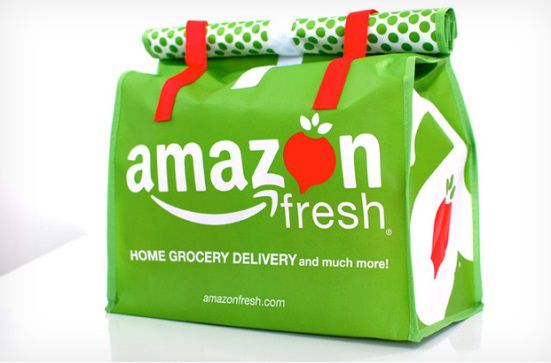PROGRESSIVE GROCER: Disruptive Retail Channels: Amazon an Army of One
Angela Grandolfo and Stephanie Halgren
In just 10 years, Amazon.com has become an indisputable force in retail. It is leading disruption of the traditional, brick-and-mortar landscape, transforming how consumers think about their needs and how shoppers approach their purchases…one category at a time. On the consumer front, it is often the first place to research, compare and explore products to meet consumer needs. On the shopper front, it has accelerated the impulse purchase and derailed the intentional car trip to the store. For many consumer product manufacturers, Amazon.com is a looming shadow that has yet to be fully addressed.
For CPGs who believe they will not be affected by Amazon’s growth in the next few years, an examination of the historical numbers is sobering. From 2000 to 2013, Amazon’s overall growth has been an astronomical 2,112 percent. Today, Amazon controls 14 percent of the consumer electronics business, and 11 percent of the personal care business. This growth has taken place as key brick-and-mortar retailers supporting those industries were forced to consolidate. In consumer electronics, Circuit City went bankrupt. In personal care, the drug channel has been forced to find pockets of growth outside of health and personal care including recent forays into prepared food.
Consumer product manufacturers historically believed that Amazon could not accommodate the small, dollar ring nature of fast-moving consumer goods. This changed with Amazon Prime and the introduction of programs such as Amazon Mom. Suddenly, leading consumer packaged goods manufacturers found themselves selling an increasing share of their high tonnage items such as diapers and baby food at Amazon.com.
The Next Frontier: Grocery
With the recent pilot of Amazon Fresh grocery delivery, Amazon will continue to increase in importance for consumer packaged goods companies. The company is currently optimizing logistics and solving for multiple temperature states, which will allow it to deliver perishable goods along with ambient products. Amazon purchased Kiva systems in 2011 to bring down the cost of distribution per shipping location and is building distribution centers within five miles of major metropolitan centers to enable same-day delivery.
Grocers have recognized the threat of Amazon.com and responded with concerted efforts in the digital space. Ahold/Peapod, Fresh Direct, Harris Teeter, Safeway and Meijer have all begun home delivery services to preempt the entry of Amazon Fresh. Walmart is competing with Amazon’s vast assortment through testing “endless aisle”– the inclusion of quick response codes at shelf that can be scanned to provide access to a wider product offering. CPG companies need to invest the same kind of energy in working with these retailers.
A Roadmap Exists
As Amazon continues to grow and its impact increases within the CPG landscape, consumer products companies need to understand how Amazon operates and develop strategies to win with customers. Common questions posed by CPGs include:
“How do we offer greater representation and how much representation is the right amount?”
“What are the best ways to partner?”
“How do we manage relative to our brick-and-mortar businesses?”
The most successful manufacturers who have worked with Amazon have provided a roadmap. Sales representation at Amazon is treated just like other large-volume retailers, including dedicated sales resources, top-to-top meetings with Amazon management, customized promotions and dialogue with Amazon staff to integrate marketing programs with Amazon consumers. Simultaneously, successful CPG companies also re-double their effort with conventional brick-and-mortar retailers, strategically protecting relationships in all retail formats.
A few key guiding principles for companies sorting out the Amazon.com portion of their business can be followed:
Understand the online (purchasing) behavior of your shopper first. Is it about education? Are they price comparing? Getting product reviews? How important is it for them to interact with the product physically? In many cases, unique shopper segments may be engaging with mobile/online for different reasons. The first step in allocating resources toward this area requires understanding what kind of programs need to exist for different shopper segments.
Assess your category potential. The approach is no different than a solid foundation for effective category leadership: What is the opportunity for your category at Amazon.com, and how can manufacturers help develop it? How will you engage with Amazon.com: On a transactional basis? Exchange customer data? Provide additional promotional funding?
Identify where Amazon.com falls in your customer segmentation. Every business should be thinking about Amazon.com, but the urgency levels may differ. For example, if your category is in beauty, then addressing Amazon.com is more critical given the prevalence of beauty product availability online than if your category is perishable…for now.
Where to Start
As CPGs approach the new online reality that includes Amazon.com and/or Amazon Fresh, three initial steps are recommended:
Assess the current and projected future impact of Amazon.com and other internet commerce retailers for your business. Understand your shopper and identify the category opportunity.
Determine a self-funding or investment approach. Determine what kind of resources (part-time, full-time) can be supported by the online business, or if investment spend is required in headcount and other support to build out the business.
Invest to understand online retailer needs and develop capability to build products and programs to meet the needs of this emerging retailer vertical. Like any other key customers, partnerships are required for success.
Amazon.com and other online retailers are and will continue to influence the business of fast-moving consumer goods manufacturers. The good news is that online can be a great, new source of growth for CPGs. The critical challenge is how to proactively address the opportunity and take advantage of the new growth outlet without sacrificing the current business.

